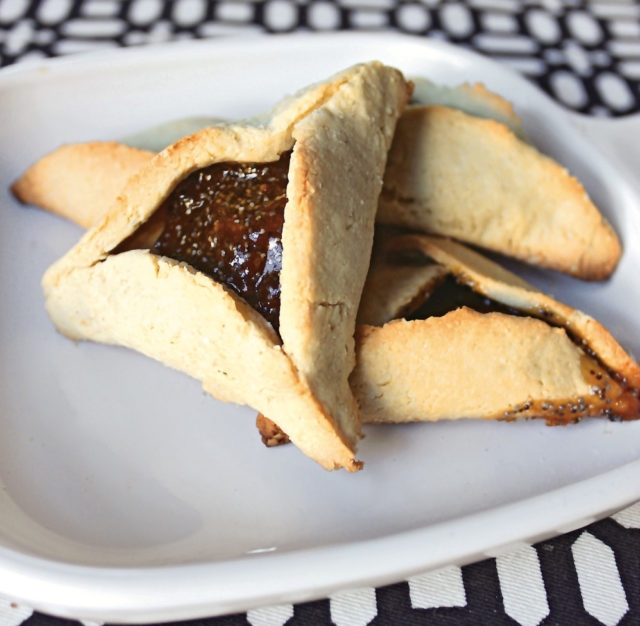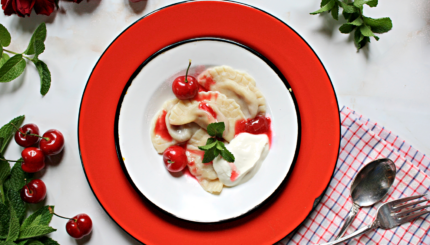One of the most frequently asked questions that we get about hamantaschen (and all desserts, for that matter) is, “What about a sugar-free recipe?” And recently, we’ve been getting more grain-free requests, too. As our gluten-free and sugar-free readers know, it’s no easy task finding such recipes; internet searches yield dicey results, and seemingly straightforward substitutes–like gluten-free flour for flour, or stevia extract for sugar–can really turn on you.
The most satisfying sugar-free and grain-free recipes fulfill three basic needs: (1) they actually work, (2) they taste good, and most importantly, (3) they remind you of your old sugary, flour-based favorites. For these reasons, we can’t recommend just any recipe.
But everything rather fortuitously changed last week when I walked into the office to find a new cookbook on my desk: The New Yiddish Kitchen: Gluten-Free and Paleo Kosher Recipes for the Holidays and Every Day. I immediately fell in love with its watercolor-washed pages, and the great diversity of recipes and wholesome ingredients.
The Nosher celebrates the traditions and recipes that have brought Jews together for centuries. Donate today to keep The Nosher's stories and recipes accessible to all.
This cookbook gracefully merges Yiddish cookery with Paleo living, which is no easy feat. Tips from Bubbe accompany every recipe, offering old-world wisdom for a grain-free and sugar-free life. (“I want that you should make this gorgeous! Just spoon a dollop of dairy-free sour cream or coconut cream for a culinary delight.”)
Writers Jennifer Robins (Down South Paleo) and Simone Miller (The Zenbelly Cookbook) wrote this book out of their love for Jewish food and whole-foods based lifestyles. They point out that holidays like Thanksgiving, Christmas, Halloween and Easter have plenty of grain-free and sugar-free alternatives. But there’s a real lack of options for Jewish holidays, and even classic deli favorites.
In their words,
“Where are the grain-and gluten-free counterparts for matzo ball soup, we ask?!…when you take away gluten, grain and dairy, those favorite Jewish foods are few and far between, to be honest.”
If you, too, find yourself craving bagels, bialys, knishes and hamantaschen that don’t make your insides kvetch, this is definitely the book for you.
And just in time for Purim, we’re pleased to have finally found a hamantaschen recipe from the book that fits the bill: dough that doesn’t crumble when you pinch the corners, fillings that taste even better than what you remembered, and cookies that disappear before you have time to photograph them.
Ingredients
These triangular, hat-shaped cookies are a childhood (and adulthood) favorite! Here are two options for fillings, raspberry and apricot, thought there are endless possibilities!
FOR THE COOKIE
1 cup (110 g) cashews
1 egg
1 cup (95 g) almond flour
Pinch sea salt
½ teaspoon baking soda
3 tablespoons (45 ml) maple syrup
¼ cup (28 g) coconut flour
FOR THE BERRY FILLING
1 cup (140 g) frozen raspberries (or fresh, if in season)
¼ cup (60 g) coconut palm sugar
½ lemon, juiced
FOR THE APRICOT FILLING
½ cup (160 g) fruit-sweetened apricot preserves
1 tablespoon (8 g) poppy seeds
This recipe is excerpted from The New Yiddish Kitchen: Gluten-Free and Paleo Kosher Recipes for the Holidays and Every Day, © 2016 by Simone Miller and Jennifer Robins. Reproduced by permission of Page Street Publishing. All rights reserved.
Directions
Preheat the oven to 350°F (177°C). To make the cookies, place the cashews into a food processor or blender and pulse until you have a “flour.” Next add in egg, almond flour, salt, baking soda and maple syrup. Blend more until all ingredients are well combined and form a dough.
Spoon the dough onto a piece of parchment paper and begin sprinkling in the coconut flour, 1 tablespoon (7 g) at a time. The dough will be sticky to start, but the coconut flour will take care of this.
Once the stickiness is gone, roll out the dough between two pieces of parchment paper until it is about ¼ -inch (6-mm) thick. Use a drinking glass or round cookie cutter (with a 3-inch [7.5-cm] diameter) to cut circles out of the dough. Set the circles aside.
To make the berry filling—which can also be made ahead if you prefer—combine the raspberries, sugar and lemon juice in a small saucepan over medium heat. Then mash the fruit until it is soft and combines well with the sugar. Allow the mixture to simmer for about 8 minutes or until it thickens and reduces. If there are any residual lumps you may briefly puree until a smoother consistency is achieved.
Alternatively, to make the apricot filling, combine the preserves with the poppy seeds and stir well.
Next, continue to assemble the cookies by taking one dough circle and placing a dollop of the raspberry filling in the center, no more than ½ teaspoon or so; do not overfill.
Then fold the circle into thirds, sealing off the edges until a triangular shape is formed. Make sure you pinch the seams closed, or they can reopen while baking.
Repeat until all of the dough is used. Place cookies on a parchment-lined baking sheet and bake for 10 minutes. Remove from the oven and allow to cool slightly before serving.
Bubbe’s tip: Want to try other flavors? The world is your Hamantaschen… try chocolate or even prunes for variety!




